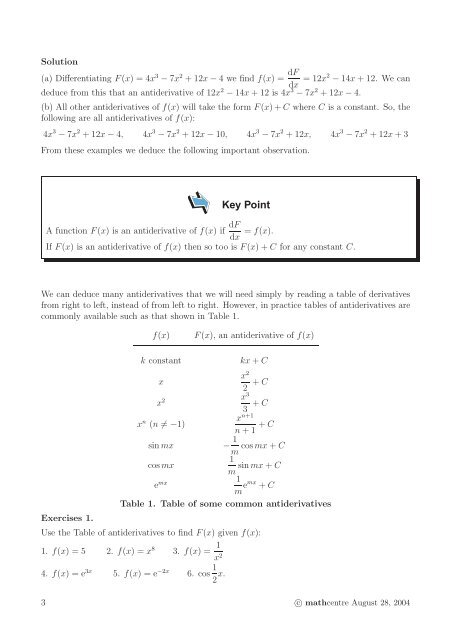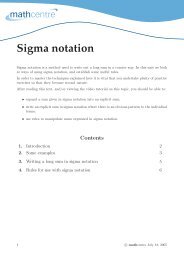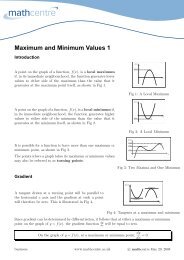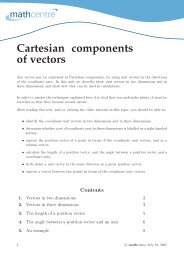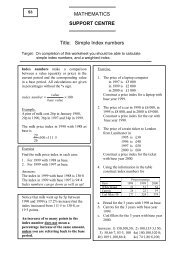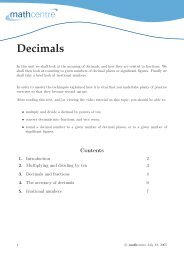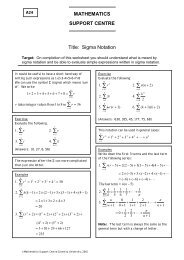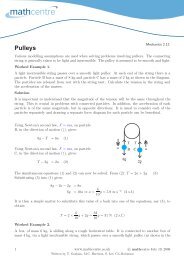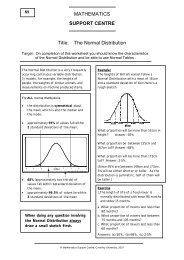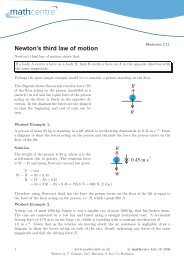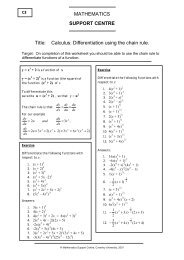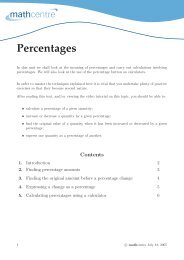indefinite integration as the reverse of differentiation
indefinite integration as the reverse of differentiation
indefinite integration as the reverse of differentiation
Create successful ePaper yourself
Turn your PDF publications into a flip-book with our unique Google optimized e-Paper software.
Solution<br />
(a) Differentiating F(x) = 4x 3 − 7x 2 + 12x − 4 we find f(x) = dF<br />
dx = 12x2 − 14x + 12. We can<br />
deduce from this that an antiderivative <strong>of</strong> 12x 2 − 14x + 12 is 4x 3 − 7x 2 + 12x − 4.<br />
(b) All o<strong>the</strong>r antiderivatives <strong>of</strong> f(x) will take <strong>the</strong> form F(x) + C where C is a constant. So, <strong>the</strong><br />
following are all antiderivatives <strong>of</strong> f(x):<br />
4x 3 − 7x 2 + 12x − 4, 4x 3 − 7x 2 + 12x − 10, 4x 3 − 7x 2 + 12x, 4x 3 − 7x 2 + 12x + 3<br />
From <strong>the</strong>se examples we deduce <strong>the</strong> following important observation.<br />
Key Point<br />
A function F(x) is an antiderivative <strong>of</strong> f(x) if dF<br />
dx = f(x).<br />
If F(x) is an antiderivative <strong>of</strong> f(x) <strong>the</strong>n so too is F(x) + C for any constant C.<br />
We can deduce many antiderivatives that we will need simply by reading a table <strong>of</strong> derivatives<br />
from right to left, instead <strong>of</strong> from left to right. However, in practice tables <strong>of</strong> antiderivatives are<br />
commonly available such <strong>as</strong> that shown in Table 1.<br />
f(x)<br />
F(x), an antiderivative <strong>of</strong> f(x)<br />
Exercises 1.<br />
k constant<br />
kx + C<br />
x 2<br />
x<br />
2 + C<br />
x 2 x 3<br />
3 + C<br />
x n x n+1<br />
(n ≠ −1)<br />
n + 1 + C<br />
sin mx<br />
− 1 m cosmx + C<br />
1<br />
cosmx<br />
sin mx + C<br />
m<br />
e mx 1<br />
m emx + C<br />
Table 1. Table <strong>of</strong> some common antiderivatives<br />
Use <strong>the</strong> Table <strong>of</strong> antiderivatives to find F(x) given f(x):<br />
1. f(x) = 5 2. f(x) = x 8 3. f(x) = 1 x 2<br />
4. f(x) = e 3x 5. f(x) = e −2x 6. cos 1 2 x.<br />
3 c○ mathcentre August 28, 2004


